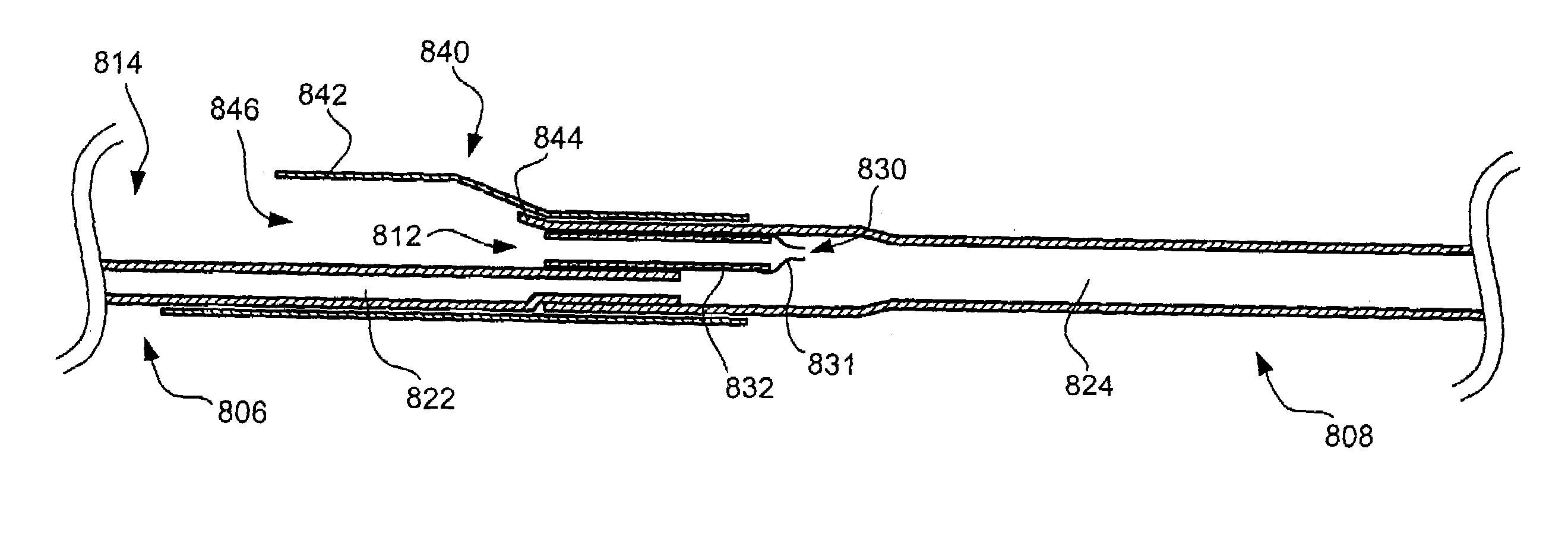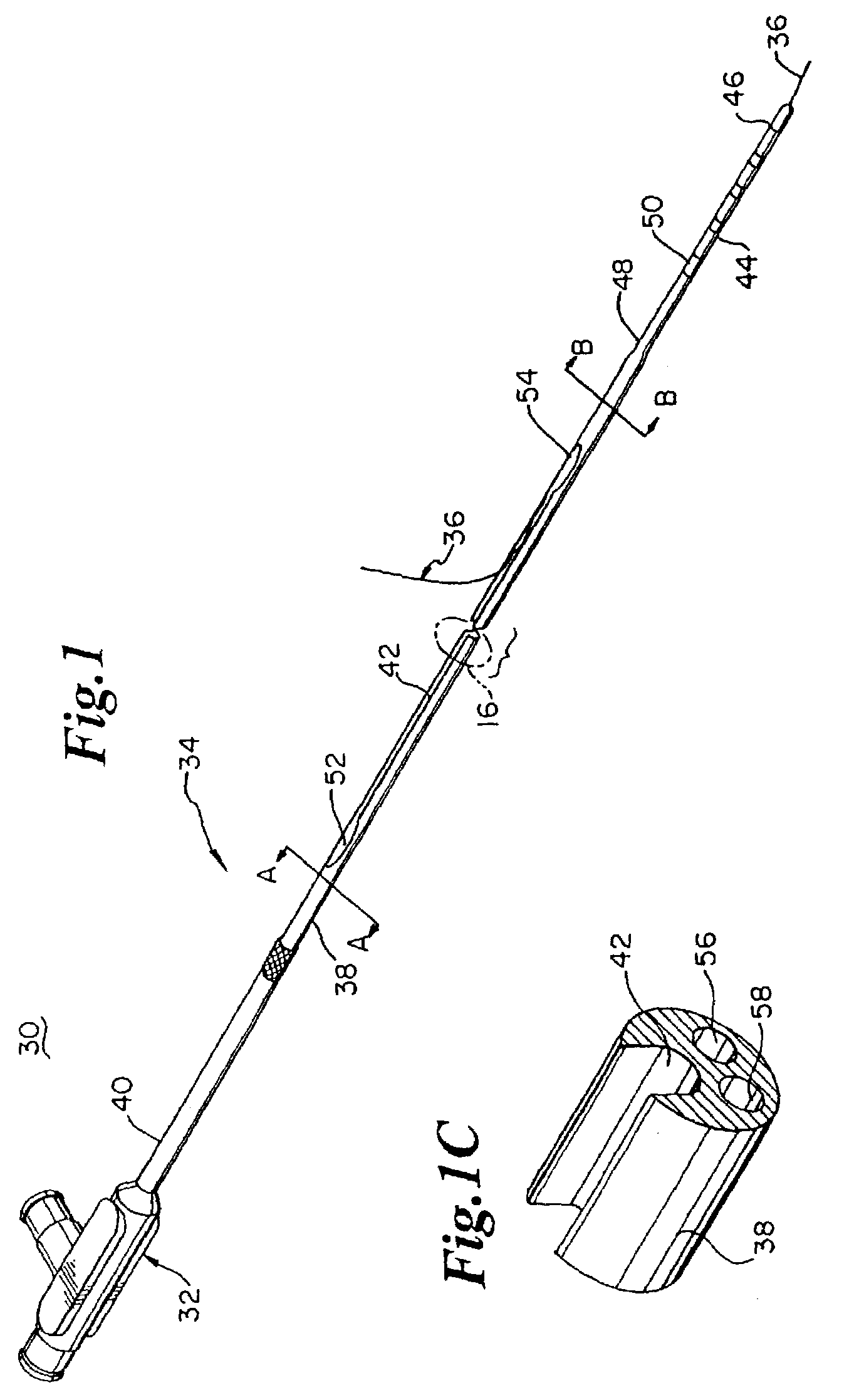Rapid exchange catheter with detachable hood
a technology of hood and catheter, which is applied in the field of catheters, can solve the problems of time-consuming and cumbersome guidewire exchange, relatively more time-consuming and costly procedures, and reduce the distal portion of the shaft profile, and facilitate single-operator us
- Summary
- Abstract
- Description
- Claims
- Application Information
AI Technical Summary
Benefits of technology
Problems solved by technology
Method used
Image
Examples
first embodiment
[0148]Refer now to FIG. 19A, which illustrates a detailed side view of the junction between the proximal shaft portion 806 and the distal shaft portion 808. FIGS. 20A–22A are cross-sectional views taken along lines 20A—20A, 21A—21A and 22A—22A, respectively, in FIG. 19A. As best seen in 20A, a seal 830 is disposed adjacent the proximal guidewire port 812. The seal 830, in this exemplary embodiment, is a duckbill-type one-way valve. However, the seal 830 may comprise any of the types discussed previously.
[0149]Duckbill-type valve 830 may comprise an elastomeric tube 831 mounted to a rigid tube 832 disposed in the guidewire lumen at the juncture between the proximal shaft portion 806 and the distal shaft portion 808. The elastic tube 831 may have a flattened distal portion or may comprise a tubular structure having opposing flaps formed in the distal end thereof by cutting two opposing slits through the wall of the tubular structure. Rigid tube 832 may comprise a stainless steel hypot...
second embodiment
[0151]Refer now to FIG. 19B, which illustrates a detailed side view of the junction between the proximal shaft portion 806 and the distal shaft portion 808. Except as described herein, the embodiment illustrated in 19B is the same in form and function as the embodiment illustrated in FIG. 19A. FIGS. 20B–22B are cross-sectional views taken along lines 20B—20B, 21B—21B and 22B—22B, respectively, in FIG. 19B.
[0152]As best seen in FIG. 20B, a hood 840 is provided adjacent the proximal guidewire port 812 to facilitate easy insertion of the guidewire. Hood 840 includes an enlarged proximal portion 842, preferably having an oval shape, wherein the minor diameter is approximately equal to the diameter of the proximal shaft portion 806 and the major diameter is substantially larger than the proximal shaft portion 806. The proximal portion 842 defines an entrance 846 that has a diameter substantially larger than the diameter of the proximal guidewire port 812, and into which the guidewire may...
third embodiment
[0153]Refer now to 19C, which illustrates a detailed side view of the junction between the proximal shaft portion 806 and the distal shaft portion 808. Except as described herein, the embodiment illustrated in FIG. 19C is the same in form and function as the embodiment illustrated in FIG. 19A. In addition, although not illustrated, the hood 840 discussed with reference to FIG. 19B may be utilized in the embodiment illustrated in FIG. 19C. FIGS. 20C–22C are cross-sectional views taken along lines 20C—20C, 21C—21C and 22C—22C, respectively, in FIG. 19C.
[0154]As best illustrated in FIG. 20C, this embodiment differs from the embodiments described previously in that the distal shaft portion 808 is inserted into a cored-out portion of the proximal shaft portion 806. Specifically, the distal end of the proximal shaft portion 806 is cored or hollowed to define a circular interior with a single wall exterior. The proximal end of the distal shaft portion 808 is inserted into the cored distal ...
PUM
 Login to View More
Login to View More Abstract
Description
Claims
Application Information
 Login to View More
Login to View More - R&D
- Intellectual Property
- Life Sciences
- Materials
- Tech Scout
- Unparalleled Data Quality
- Higher Quality Content
- 60% Fewer Hallucinations
Browse by: Latest US Patents, China's latest patents, Technical Efficacy Thesaurus, Application Domain, Technology Topic, Popular Technical Reports.
© 2025 PatSnap. All rights reserved.Legal|Privacy policy|Modern Slavery Act Transparency Statement|Sitemap|About US| Contact US: help@patsnap.com



